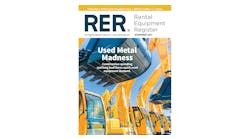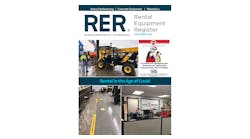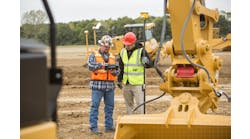Pressure washers, now routine items in the equipment inventory, are an everyday money earner for many rental businesses. New performance developments may offer an opportunity for increased sales and higher margins on equipment designed to accommodate faster, more effective cleaning, while conforming to current and forthcoming environmental concerns and regulations.
Larger pressure washer machines in the 16- to 35-hp range are now available, and can rent for substantially more than the smaller units. The advantage to the renter is that the large washers clean much faster and more effectively than smaller machines, thus reducing labor costs. Also, with 6- to 15-gpm units, multiple operators can use the machine simultaneously. High-pressure (4,000 to 7,000 psi), moderate-volume units are designed for rapid cleaning of concrete, equipment, floors or parking garages; lower pressure (2,000 psi) high-flow-rate units are designed for wood fence, shingle roofing or after-construction clean-up. The more powerful units offer a competitive edge and an additional opportunity for rental sales.
When renters see the profit opportunities created from increased work speed, they will likely return to rent more frequently. Also, the large pressure-washer machines are more rugged and dependable, offering lower maintenance costs and less outage due to repairs than smaller units designed for homeowners and similar low-duty applications.
Environmental concerns will form an important rental market for pressure washers. Storm-water drains usually flow directly into nearby oceans, lakes or rivers without any treatment whatsoever. Anything other than precipitation water might contain pollutants that adversely affect the receiving waters, and based on environmental concerns, and following federal and state mandates, many cities and towns have enacted laws prohibiting discharge of any type of non-storm water into the storm-water system. The Storm Water Conveyance System, as it is typically called, includes roads, streets and even the gutters. Commercial pressure-washing operations are specifically included in the rules for many municipalities. Disregarding these regulations can lead to substantial fines and legal exposure. The rules are clear: No wash-water down storm drains!
Regulations mean more rentals
Rental companies furnishing pressure washers to commercial operators can enhance their income by informing customers about the local regulations regarding discharge into storm drains of wash water. Following federal and state guidelines, many municipalities now prohibit any discharge into the storm-water systems (with minor exceptions). Washing a grocery parking lot, for example, requires the operator to prevent wash water from entering streets or gutters leading to storm drains. So renting a power washer to a contractor has now become an opportunity to also rent wash-water control equipment.
Further complicating the issue, in many states the owner of the property is the legal owner of the wastewater produced at his property. If the pressure-washer user permits an illegal discharge to the storm sewer, it might be his customer who gets the citation and fine. In addition, the rental company may be at risk if it does not inform the renter of the discharge regulations.
The answer to all these concerns is to provide the right equipment for rent to easily capture the wastewater before it gets in the street or gutter, renting it routinely as an add-on to high-performance pressure-washer rentals. Rent a powerful pressure washer to maximize work speed, together with the proper vacuum wash-water control system to comply with the law. Wash-water control rentals can range from just $10/day add-on to a $500/day system with auto-pump-out capable of handling floods to 100 gpm.
The captured wastewater — if no hazardous pollutants are present and with the owner’s permission — may usually be used to water landscaped areas as long as there is no runoff to storm drains. Local regulations in communities with steep cliffs may forbid such discharge, however, as well as some desert localities concerned with possible damage to native plants. Usually it is perfectly acceptable to discharge the wastewater into the property owner’s sanitary sewer connection (sink or toilet), as long as the discharge rate does not exceed 20 gpm.
To guide rental customers, one approach might be to attach a highly visible plastic tag to rental pressure washers with wording such as, “It is a misdemeanor, subject to fines, toallow waste wash water to enter the storm-drain system. Rent our wastewater control equipment to avoid citation.” Similar wording on the rental contract ensures that the customer has been notified and draws attention to the availability of proper wash-water control equipment.
Rental inventory compliance
The basic idea in wastewater control is to block all water access to restricted areas leading to storm drains, and then use a vacuum to capture and remove the water previously used for washing. Typical systems use small, flexible dams or berms to block the water and deflect it to collection areas. Often a vacuum collection device is incorporated, forming a vacuum berm. Vacuum hoses lead water collected by the berm to one or more screen and filter tanks, whose function is to isolate the vacuum pump from the collected water, and to pump the water to a sanitary sewer or a suitable disposal region. The most important part of wash-water control is the vacuum pump, which can be a low-cost, fan-driven device for small jobs, or a roots-blower-based machine requiring engine or motor power upwards of 6 to 25 hp.
Vacuum berms
Vacuum berms are the business end of the wastewater vacuum recovery system. They are flexible dams, 3 to 6 inches high, arranged to intercept running ground water resulting from washing operations. Rows of holes at ground surface suck up entering water when hooked to a vacuum system. The latest designs will impound and collect all the water encountered by the berm, leaving a dry surface on the lee side of the berm. Technically quite sophisticated, the units are simple in function and extremely rugged and dependable. Sold in 4- to 6-foot lengths, they can be hooked together for more extensive control. Smaller units (1½ feet long) are used to continuously empty puddles or low spots. De-watering rates of 4 to 10 gpm per section can be achieved. Typical costs for these devices run $60 to $75 per foot of length.
Auto pump-out and filter tanks
One or more receiving tanks (waste tanks) are required between the vacuum berm and the vacuum pump in order to intercept the recovered wastewater and prevent it from entering the vacuum pump. Typically these tanks are 30- to 55-gallon covered drums, strong enough to resist full vacuum in case of a plug somewhere. A small pump, such as a submersible sump pump, inside the tank, discharges the wastewater to adjacent landscaping or the sanitary sewer at up to 15 gpm. The tank is usually fitted with a screen to trap debris and protect the discharge pump. A filter can be provided on the pump discharge in case the water is to be reused in the washing operation. In case of high water levels in the tank, controls shut down operation to prevent damage to the vacuum pump.
Vacuum pumps
Vacuum pumps are a big step up in size and power from shop vacuums and are capable of handling the discharge from multiple pressure-washer cleaning operations. Typical units are engine-driven, positive displacement, roots-blower vacuum pumps with power to screen and filter the recovered water if required, and capable of handling 5 to 50 gpm with vacuum hose lengths of more than 400 feet. Engine-driven versions are independent of on-the-job power sources, which may be limited. For small recovery jobs, electrically driven vacuum fans are available. Many rental centers already rent vacuum equipment, so rental companies can combine these with vacuum berms and interceptor tanks to form a more profitable, environmentally friendly rental item.
Rental opportunities
The growing number of federal and state wastewater regulations have created new streams of revenue for rental companies on pressure-washer rentals. Rental managers may consider coupling the rental of current pressure-washer models with appropriate shop vacuums and vacuum berms. Renting larger pressure washers and blower-driven wastewater control gear will protect the customer from costly fines and create additional revenue for the rental company.
Complete units
The cost of complete units with engine drive and blower; vacuum berm; screen and filter tank with automatic pump-out; and hoses rated at suction lifts of up to 12 feet at 40 gpm water recovery rate, typically run in the range of $5,000 to $7,000.
Wash-water control equipment rental is inexpensive compared to the fines and citations that can result from noncompliance, and no rental company or contractor wants to lose a customer over an environmental infraction.
Informing the power-washer renter of his responsibilities can lead to increased and profitable usage of wash-water control equipment. Tags on the power washer and prominent mention of the “no discharge” rule on the rental contract not only provide benefits and protection to the rental company, but also aid in preserving and enhancing the environment. Understanding and abiding by environmental regulations relating to wash water can help rental companies increase profits. RER
Jerry McMillen is president of Pressur Washer.net, a manufacturer of power washers and wash-water control and recycling equipment based in El Cajon, Calif. Dr. J.W. Hoyt, a consultant to for the company, assisted in preparing this article.





